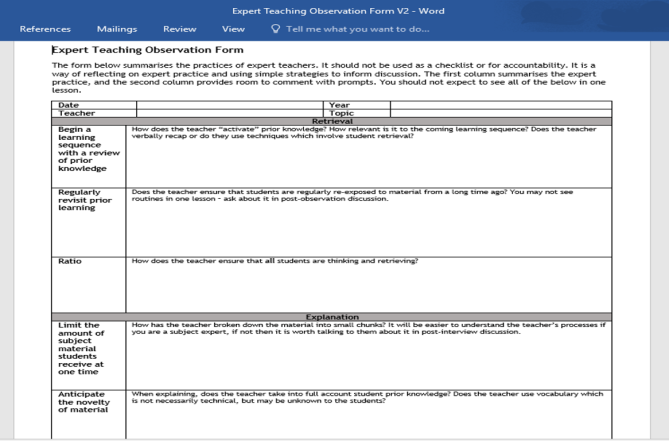
Update 13/2/20: if you like this form or are planning to use proformas of any kind when observing lessons, please read thisblog by David Didau. In addition, please note that the way you observe “expert” teachers should be very different to the way that you observe “novice” teachers, and I have written further about an approach to the latter here.
A little while back, I wrote this observation form based on Rosenshine’s principles of instruction. I think it was a good start, but it had some limitations. First, I don’t think that the principles are particularly well organised or sequenced, and needed some work in terms of categorisation. I also don’t think that I gave enough thought to the subject specificity of the lesson being observed. I’ve been thinking quite a bit about this recently, and think that it’s vitally important to understand that a non-subject-specialist can only see so much in a lesson. If you are interested, I wrote more about that here. I also felt there was a lot of stuff I had been learning from Doug Lemov’s materials as well as other bits and pieces that should be included.
Anyway, I’ve souped up the form. I’ve re-ordered it so it is now structured to focus on retrieval, explanation, practice, review and culture. As with before, I’ve written some question prompts to go in the boxes to get the observer thinking. Before you use it, please read the points below:
- This is not designed as a performance management or accountability tool. This is to help the observer and the observed reflect on what expert practice looks like in their subject
- It is long, and you shouldn’t expect to write something for every box in the course of one lesson. Either see lots of lessons, or don’t fill out the whole thing
- I’ve written a couple of demonstration forms filled in already. Please read them first, I’d really like you to look at the subject specificity involved
- Further to the above, you should see how the form is not to be used as a checklist, in one of the forms for example, the observer concludes that an explanation was longer than you would normally expect when using a “chunking” approach, but in this case was appropriate
- Just going to say that again, it’s not a checklist – it’s a prompt for thinking
- Jo Morgan has also been kind enough to write a demo one, it’s very interesting to compare our styles and the kind of things that a maths teacher might be looking for
- Stuff from Lemov and others is sometimes explicitly referenced, but sometimes it’s just wired in. If you’re looking for reasoning behind any of the sections feel free to ask
- The “culture” section is pretty sparse, and is really only just a check yes/no. I think a whole separate form would need to be written if you were looking more closely at relationships. Maybe a future project for someone.
- If you do use it and are willing for typed up notes to be shared then that would be an amazing help so please do let me know if you do that
I also wanted to thank Tom Sherrington, Efrat Furst and Bob Pritchard and Jude Hunton for giving me feedback on my first drafts of this form.
Finally again: remember, it’s not to be used as a checklist! It is a prompt for thinking. The last thing we want is for people to think that the practices identified must be adhered to unbendingly or in every lesson. Please don’t use it like that.
Expert Teaching Observation Form V2
Expert Teaching Observation Form V2 chemistry year 11
May 7, 2019 at 8:09 pm
This is brilliant Adam thank you for sharing.
LikeLiked by 1 person
May 7, 2019 at 11:10 pm
Thanks so much for this. I’m about to start rates and this really helped my with my thought process.
LikeLiked by 1 person